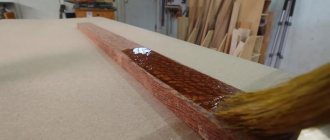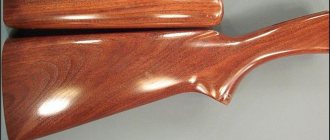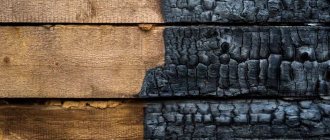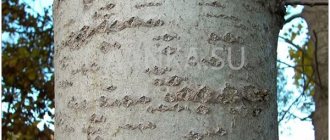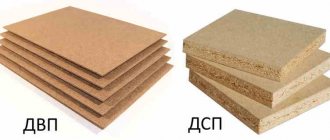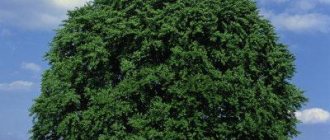Flaxseed oil is traditionally used to treat houses and wood products. Undoubtedly, linseed oil for wood is a valuable product that best ensures the safety and protection of wood material. The classic version involves using the product in its pure form. However, despite the obvious advantages, the traditional product has certain disadvantages that cause inconvenience in its use and limit its scope of use.
Modern industry offers many professional impregnations based on linseed oil, in which all the advantages of the product are most clearly manifested and at the same time its disadvantages are completely eliminated. In this review, we will look at both of these products and find out what effect their use has on wood.
Properties and features of linseed oil
Flaxseed oil is a natural product. It is made from flax seeds, which undergo various processing methods at the production stage:
- Pressing (cold or hot).
- Extraction.
Oil produced by cold pressing contains fewer impurities, has a mild odor and has a longer shelf life.
Hot pressing produces an oil with a specific smell and taste and an intense color.
Extraction involves separating the oil using solvents. The resulting product is subjected to refining, resulting in the formation of pure, lightly colored fat with virtually no odor.
Types of oil
Depending on the method of production and processing, the output is a product endowed with certain properties and characteristics:
- Unrefined oil. It has no mechanical impurities and retains all its properties (smell, color and taste). During prolonged storage, the product deteriorates and forms sediment.
- Hydrated oil. It is an unrefined oil treated with water. As a result, the properties of the original product are preserved, but without the formation of sediment.
- Refined oil. It is processed with alkali, resulting in pure oil without sediment, with low color and odor and a long shelf life.
Which oil is better: edible or technical?
All of the above types refer to edible oils that can be used for wood processing.
However, not everyone knows how long food compositions take to dry. Please note that these products have a long drying period. After treatment, at least 7 days must pass before the surface dries and it becomes possible to apply the next layer of oil impregnation. It should be noted here that since the oil is highly absorbent, 3-5 or more layers will be required to obtain a high-quality coating. Thus, the processing process can take one and a half to two months.
Unlike food grade, the polymerization process of technical linseed oil proceeds much faster. A durable protective film is formed on the surface, protecting the wood from moisture and insects. Due to this property, technical oil is most often used in the construction industry to stabilize wood.
Fire hazard
Any vegetable oil, including flaxseed, is an organic substance that, upon reaching a certain temperature, ignites in the open air. Oil can also ignite when placed in close proximity to an open flame.
However, when applied to wood, the oil does not increase its flammability. Over time, oxidative processes occur in the oil. As a result of oxidation, the oil no longer supports combustion.
Advantages
Before and after treatment
Flaxseed oil has characteristics that are most valuable when applied to wood - good waterproofing, antiseptic and protective properties.
- Wood treated with flax composition receives reliable protection from moisture, blue staining, and damage by microorganisms, including various types of fungi. Using linseed oil can prevent wood from drying out and cracking.
- Oil has the ability to be completely absorbed into the wood, penetrating into the deepest layers. Only the smallest part of the applied product remains on the surface. This protects not only the outer surface, but also the inner layers of wood. Flaxseed oil does not form a film and does not deprive the wood of its ability to “breathe”.
- The use of linseed oil improves the aesthetic characteristics of wood. The surface becomes matte, the oil coating emphasizes the natural beauty of the wood grain.
- Flaxseed oil is great for updating old wood products. It masks small cracks, abrasions and other minor defects, and gives the surface dirt-resistant properties.
Inexpensive price and availability (oil can be bought at any pharmacy or hardware store) add to the popularity of linseed oil, which today is one of the most popular means for processing wooden products.
Flaws
One significant disadvantage of using edible flaxseed oil has already been noted above - the long drying period. This disadvantage is partially compensated by the use of a technical composition, which allows the polymerization process to be accelerated.
However, the use of a pure product has other disadvantages:
- Polymerization of oil in the inner layers of wood has lower rates than on the outside. As a result, a seemingly dry product can leave greasy oil stains when touched for a long time.
- Under the influence of ultraviolet radiation, the drying period is reduced, but another disadvantage arises here: in the sun, the color of the coating changes, which acquires a yellowish tint.
- Wood treated with pure linseed oil needs regular renewal. The processing frequency is once every 6-8 months.
Popular projects on our website
Project a1
Project a2
Project a3
Our website presents a number of log house projects, for example: Or you can see all prices for log houses. You can calculate the house or bathhouse you need with maximum accuracy using our log house cost calculator. To order and buy a log house, call:
- Vologda
- Moscow,
Comments
No comments yet.
Improved performance
Using linseed oil in its pure form, the question of improving the characteristics of the product invariably arises. There are a variety of folk and professional means for this. Let's look at both in more detail.
Acceleration of polymerization
If edible linseed oil is used to treat a log or timber house, the following products are included in the product to reduce drying time:
- turpentine;
- tar;
- wax.
When choosing a means to speed up the reaction, you need to take into account that turpentine is quite toxic, which limits its use only on external surfaces. In addition, it can cause skin burns and allergies, so you need to use protective equipment when working with it.
Tar is the same as turpentine, it is obtained as a result of distillation of wood. It is less toxic, but it is also undesirable to use indoors.
Wax is absolutely harmless and can be used both outside and inside the house. It is one of the best sauna treatments because it does not form a film coating and can also be used for steam room shelves. Wax is used both in pure form and in tandem with linseed oil. To prepare the composition, the wax must first be heated in a water bath.
Cleaning the composition
As has been noted, when exposed to UV rays, linseed oil turns yellow. To prevent the log from yellowing in the sun, the composition is cleaned of impurities before application. The following methods are used for this:
- preparing saline solution;
- adding lead salts;
- mixing with ethanol;
- exposure to light (photo-oxidation).
Color change
To give a particular shade, linseed oil is tinted using natural pigments.
Beautiful colored coatings are obtained by first covering the wood with stain and then applying transparent oil. In this way you can achieve a wide variety of shades: from natural to bright exotic. Some craftsmen, to tint the oil, use improvised means, for example, spices: turmeric to color it yellow, paprika to give it a red tint, carrots to color it orange. In some cases, oil paints or gouache are added to the oil.
Professional products
All of the above methods are used exclusively by home craftsmen in order to save money.
All of them are available, but at the same time they significantly complicate and lengthen the painting process. When using pure linseed oil, improved with improvised means, it is impossible to achieve high quality painting and durability of the coating. Today there are many professional products based on linseed oil, produced under the brands Osmo, Tikkurila, Remmers, Biofa, GNature, Teknos and others. The products of these companies have become widespread and have earned many positive reviews from consumers.
Impregnations include additional components that improve the quality characteristics of linseed oil:
- driers to speed up the polymerization process;
- additives that increase resistance to UV radiation and increase the protective and water-repellent properties of the oil;
- antiseptic additives;
- color pigments.
Manufacturers produce different types of impregnations intended for internal and external processing. You can choose glazing (transparent) or tinting coatings that give the wood the selected shade. A wide palette of colors allows you to choose the product to suit any interior.
In the product line of each manufacturer you can find specialized oil impregnations:
- for covering various elements of the house: floors, ceilings, walls;
- for baths and saunas;
- for processing furniture and countertops;
- for terraces and decking.
Each product has a specially developed composition that allows it to effectively solve the assigned tasks, and its own application technology. Impregnations based on linseed oil have good absorption and low consumption. The service life of coatings obtained using professional impregnations increases to 8-10 years.
FAQ
In my bathhouse, the shelves and handles turned black, most likely from dirt. How can I restore color?
Only sanding will help remove the blackness. If the dirt is deeply absorbed, after sanding, go over the wood with hydrogen peroxide, then saturate it with a special oil.
The shelves in the bathhouse are quickly turning black, and a neighbor advised us to treat it with SUPI SAUNASUOYA. Will this help keep it clean for a long time?
The protective composition SUPI SAUNASUOYA (TIKKURILA) has proven itself to be effective when treating walls and ceilings in a bathhouse. But it cannot be used for processing a shelf.
I coated the shelves with linseed oil, but at the first fire the pain appeared in my eyes. What to do?
Stinging in the eyes is a reaction to oil evaporation with increased sensitivity to odors. The oil will gradually polymerize and the sensation will go away. To speed up the process, heat the sauna several times at maximum temperature (of course, without your own presence).
The correct choice of oil for impregnating wood and adherence to the technology for its application will help maintain the cleanliness and impeccable quality of the shelves in your steam room.
Oil application technology
Stages of work
Work on processing a house made of timber or a log house will be similar. Conventionally, they can be divided into three main stages:
- Surface preparation. This stage includes surface cleaning and grinding. If you are painting a new house with a painted surface, first of all, remove the old paintwork.
- Priming and antiseptic. This step is required if pure oil is used. If processing is carried out by professional means, you must follow the manufacturer's recommendations. Some impregnations already contain an antiseptic and primer, which must be indicated in the instructions.
- Direct application of impregnation.
The process of applying oil to wood is described in detail in the article “How to treat a wooden house with oil with your own hands.” Therefore, in this review we will not dwell on the description of all stages, but will provide only the basic rules for oil painting.
Oil painting rules
Before starting work, it is necessary to determine the moisture content of the wood.
The optimal indicator in this case is 15%. Air humidity during painting is also essential. It should be within 80%.
Conifers with high resin content must first be impregnated with white spirit.
When painting wood with pure linseed oil, at least 4 layers are required to obtain a better result. When using professional products, you must follow the manufacturer's instructions. As a rule, to achieve the desired effect, impregnation manufacturers recommend applying 2 layers to unpainted wood and one to painted wood.
The oil should be applied along the grain of the wood using a stiff brush with artificial bristles or a lint-free cloth.
Be sure to sand between layers after each layer of oil has dried.
After the last layer has completely dried, the wood is polished with suede. Polishing allows you to give the surface an even, beautiful shine.
To check the quality of the resulting coating, you can apply a few drops of water. If the liquid remains in place, then the treatment was done well.
How to process wood
Flaxseed oil for impregnating wood can be purchased at any hardware store. The price is not high. If you plan to finish the job as soon as possible, then buy wax as well. They need to be heated and mixed. But under no circumstances should the mixture be boiled, otherwise burns may appear on the surface of the structure.
Now you need to take a sponge and rub the resulting substance into the wood. A very thin layer of lubricant must be applied. You need to make about 6 circular movements. Bubbles begin to appear on the tree. This means that everything has been done correctly and the process has begun.
DIY painting mistakes
Often, unprofessional craftsmen, having received superficial information from the Internet about oil application technology, perform the work themselves. This inevitably leads to errors in work, which affect the quality of painting.
Below are typical mistakes that non-professionals often make:
- Violation of technology. Despite the fact that in general the process of applying different types of oil is the same, each impregnation has its own unique composition, which introduces certain nuances into the rules for treating wood with this product.
- Insufficient surface preparation. Many people do not pay due attention to the preparatory work, do not clean off the old coating well, do poor-quality sanding, and leave uneven spots and cracks. As a result, after applying the oil, all defects come out, which greatly deteriorate the appearance of the coating.
- Carrying out work at high wood humidity. Humidity is a very important indicator; if you apply oil to undried wood, the impregnation will not be able to penetrate into the deeper layers and provide full protection.
- Delays or rushed work. Unfortunately, this mistake is often made by contracting organizations. Compliance with the timing when applying the coating is very important. The first layer must sufficiently saturate the surface before applying the next one. It is also important to apply a second coat before the surface becomes covered with dust and dirt. After all, wood undergoes deep cleaning before painting and should not be left unprotected for a long time. Violation of deadlines under a construction contract may cause a violation of painting technology.
To avoid these and similar mistakes, contact professionals. has more than ten years of experience in finishing and processing wooden houses. Our company pays special attention to quality; all work is carried out under strict control by the technical supervision department.
We are official dealers of well-known manufacturers of professional products based on linseed oil Osmo, Remmers, GNature, Biofa, Wooden Wood, Ramsauer, thanks to which we can provide special conditions for our customers. When ordering home treatment with oils from these manufacturers, the cost of the products is calculated at the wholesale price.
Our partner is also legal. This is a team of specialists focused on disputes in the construction industry. We always recommend the legal services of this company to our clients who have fallen into the hands of charlatan builders. If suddenly your choice is not our company, then before making payments and making advances to the contractor, conduct a legal analysis of the terms of the contract . This will help save you hundreds of thousands of rubles.
We provide services in Moscow and neighboring regions, to leave your request, contact us using the coordinates on the “Contacts” page.
Calculate the cost of painting and insulating your home right now
Select types of work:
Select materials:
The need for bath treatment
As noted above, a bathhouse is a room with special conditions in which high temperatures and humidity are constantly present. Wood is characterized by high hygroscopicity, that is, it strongly absorbs moisture.
In a steam room, the tree becomes an ideal environment for the development of pathogenic processes. Microorganisms appear in it, insects settle, mold and mildew form. As a result, the tree can completely turn black and turn into dust.
Once the process has begun, it is very difficult to stop, especially when it comes to a fully functioning steam room. To prevent the occurrence of such manifestations, it is necessary to protect all internal parts of the bathhouse frame in advance at the construction and finishing stage by treating them with special compounds.
There are many products for interior treatment of a wooden house and bathhouse. This review is dedicated specifically to oils, so we will only consider oil formulations.
What is the difference between waterproof plywood and regular plywood?
Ordinary plywood, like natural veneer, deforms and delaminates under the influence of moisture. You can increase the water resistance of the material on the outside by coating the plywood with certain compounds. And from the inside - using special adhesive mixtures to connect the veneer plates from which the sheet is made. It is the composition of these substances that creates moisture resistance. The processed product acquires the properties of a strong and durable board that can withstand direct exposure to water.
Based on the level of moisture resistance and adhesive composition, plywood is divided into grades:
Plywood grades
| Brand | Description and purpose |
| FBA | Albumin-casein glue is used for production. The material is environmentally friendly. Moisture resistance is low, so it is used only for interior work. |
| FC | It is made on the basis of urea glue with phenol additives. It has a low level of moisture resistance. Used for interior work without the possibility of use in rooms with high humidity (bathrooms, loggias). |
| FSF | The material is created using phenol-formaldehyde resins and is therefore toxic. The product is valued for its strength and high level of moisture resistance. Do not use in residential areas. |
| FBK | The binding adhesive contains moisture-resistant bakelite varnish. It has a high degree of moisture resistance. Not afraid of fungus. Does not burn. It's very expensive. Used for outdoor work. It is used in construction as a formwork material. |
Having studied the features of plywood panels, choosing a material that meets your specific needs will not be difficult.

